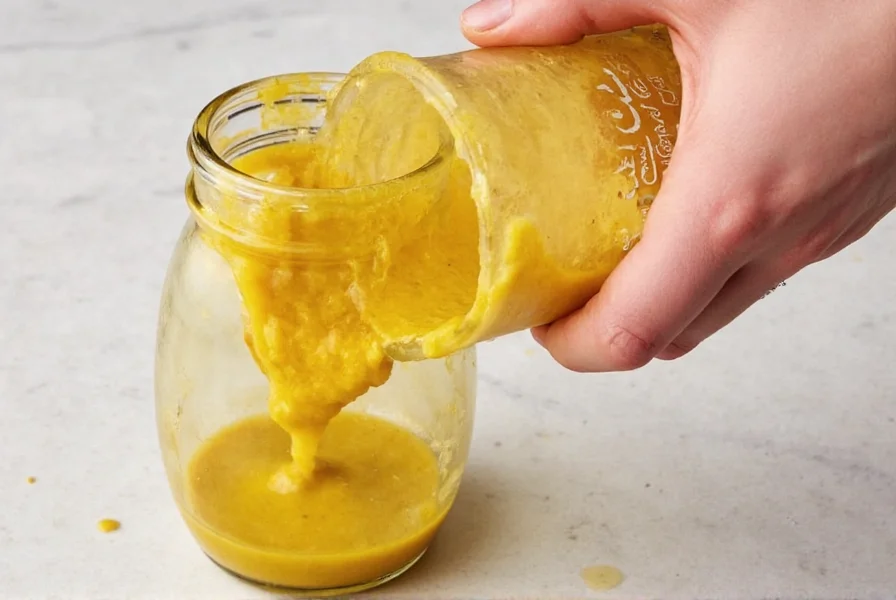How to Make Mustard Vinegar Dressing (3 Easy Variations)
This simple mustard vinegar dressing takes just 5 minutes to prepare and transforms any salad or marinade. No special equipment needed—just whisk together common ingredients for a tangy, restaurant-quality result. Perfect for beginners and busy cooks!
Basic Mustard Vinegar Dressing Recipe
Ingredients:
- 2 tablespoons Dijon mustard
- 3 tablespoons apple cider vinegar
- 1/4 cup extra virgin olive oil
- 1 teaspoon honey or maple syrup
- 1/2 teaspoon salt
- 1/4 teaspoon black pepper
Instructions:
- In a small bowl, whisk together mustard, vinegar, honey, salt, and pepper until smooth.
- Slowly drizzle in olive oil while continuously whisking until fully emulsified.
- Taste and adjust seasoning as needed. Store in an airtight container for up to 2 weeks.
3 Delicious Variations
1. Arugula & Goat Cheese Salad
- Ingredients: 4 cups baby arugula, 1/2 cup crumbled goat cheese, 1/4 cup sliced almonds, 1 tablespoon balsamic reduction
- Instructions: Toss arugula with 2 tablespoons basic dressing. Top with goat cheese, almonds, and balsamic reduction.
2. Grilled Chicken Grain Bowl
- Ingredients: 1 cup cooked quinoa, 1 grilled chicken breast (sliced), 1/2 cup cherry tomatoes, 1/4 cup pickled red onions, 1 tablespoon chopped parsley
- Instructions: Whisk 1 tablespoon whole-grain mustard with 2 tablespoons white wine vinegar, 2 tablespoons avocado oil, and lemon zest. Toss with quinoa, chicken, tomatoes, and onions. Top with parsley.
3. Roasted Beet & Citrus Salad
- Ingredients: 2 roasted beets (sliced), 1 blood orange (segmented), 1/2 fennel bulb (thinly sliced), 1/4 cup microgreens
- Instructions: Combine 1 tablespoon yellow mustard, 2 tablespoons champagne vinegar, 3 tablespoons olive oil, 1 teaspoon honey, and orange zest. Toss with beets, oranges, and fennel. Top with microgreens.
Pro Tips for Perfect Dressings
- Emulsion Secret: Always whisk vinegar and mustard first before adding oil. Cold ingredients help maintain stability.
- Oil Choice: Use extra virgin olive oil for richness, avocado oil for creaminess, or grapeseed oil for lightness.
- Storage: Keep in glass jars for best results. Separation is normal—just shake well before use.
- Marinade Hack: Add 1 extra tablespoon mustard to your dressing for meat marinades. Marinate chicken or pork for 2-4 hours for maximum tenderness.
Choosing Quality Ingredients
Mustard Selection:
| Brand | Type | Best For |
|---|---|---|
| Grey Poupon | Dijon | Fancy dressings, steak sauces |
| Maille | Whole Grain | Heartier salads, rustic dishes |
| French's | Yellow | Mild-flavored dishes, kids' meals |
Vinegar Selection:
| Brand | Type | Best For |
|---|---|---|
| Redmond | Apple Cider | Bold green salads |
| Luxury Selection | White Wine | Delicate seafood dishes |
| Napa Valley Naturals | Champagne | Elegant dinner parties |
Frequently Asked Questions
How long does homemade mustard vinegar dressing last?
Homemade mustard vinegar dressing typically lasts 1-2 weeks when stored in an airtight container in the refrigerator. The acidity from vinegar acts as a natural preservative, while mustard helps maintain emulsion stability. Always shake well before use.
Can I make mustard vinegar dressing without oil?
Yes! Use 3 parts vinegar to 1 part mustard with a touch of honey for balance. This oil-free version works well for dipping or light dressings, though it won't have the creamy texture of oil-based versions.
Why does my dressing separate?
Separation occurs when oil and vinegar aren't properly emulsified. To fix: 1) Whisk vinegar and mustard thoroughly before adding oil, 2) Add oil slowly while whisking continuously, 3) Use cold ingredients. If separation happens, simply whisk vigorously or add 1/2 teaspoon mustard to re-emulsify.
What's the difference between mustard types?
Dijon (pH 3.2-4.0) offers sharp complexity ideal for sophisticated dishes. Whole-grain (pH 3.5-4.2) provides rustic texture and visible seeds for hearty salads. Yellow mustard (pH 3.5-4.5) delivers mild tanginess perfect for beginners and kid-friendly meals.
Why This Works
Mustard's natural emulsifiers (mucilage) bind oil and vinegar while adding depth, and vinegar's acidity brightens flavors without overpowering. This science-backed combination creates balanced dressings that elevate everyday meals. For maximum health benefits, use organic vinegars with "mother" and extra virgin olive oil—no added sugars or preservatives needed.











 浙公网安备
33010002000092号
浙公网安备
33010002000092号 浙B2-20120091-4
浙B2-20120091-4